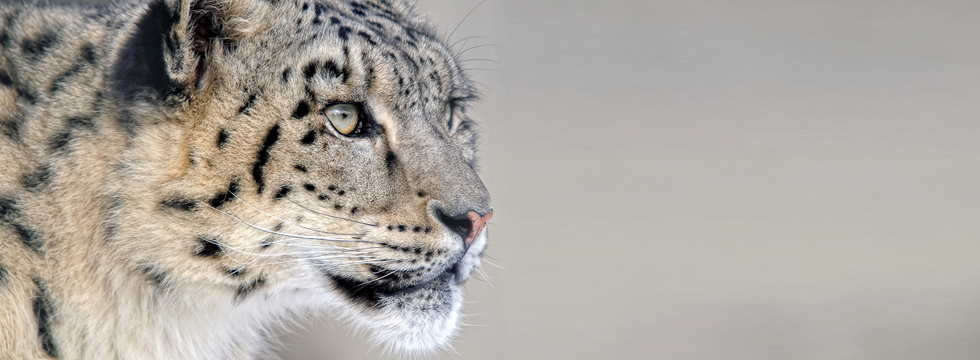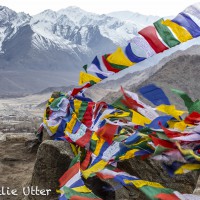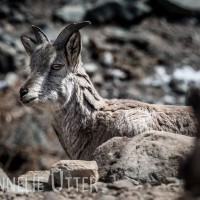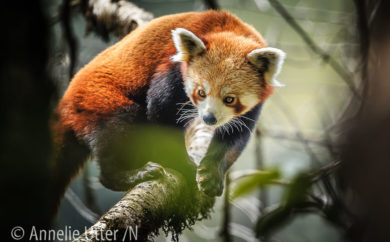Indien – Kashmir och Snöleopardens rike
17e Februari – 29e Februari – 2024
(Preliminära datum och program)
Vandra och fotografera i Himalaya
 På vår vandringsresa till Himalaya tar fotografen Annelie Utter/N med er till Indien för att se det skygga och mytomspunna kattdjuret snöleoparden. Förutom häpnadsväckande landskap med bedövande vacker natur bjuder resan även goda chanser att se Yak (Wild Ox), Lynx, Red fox, Ladakh Urial, Tibetan Argali, Ibex, Pallas cat och om man har tur även varg.
På vår vandringsresa till Himalaya tar fotografen Annelie Utter/N med er till Indien för att se det skygga och mytomspunna kattdjuret snöleoparden. Förutom häpnadsväckande landskap med bedövande vacker natur bjuder resan även goda chanser att se Yak (Wild Ox), Lynx, Red fox, Ladakh Urial, Tibetan Argali, Ibex, Pallas cat och om man har tur även varg.
Hemis National Park är en högt belägen nationalpark i östra Ladakh i den indiska regionen Jammu och Kashmir. Här har 16 däggdjursarter och 73 fågelarter observerats. Här finns cirka 200 snöleoparder. Av fåglarna kan nämnas: Himalayan Griffon, Golden Eagle, Lammergeier (även kallad Bearded Vulture), Chukar partridge, Himalayan Snowcock, Brown Accentor, Robin Accentor, Tickells Leaf Warbler, Tibetan Snowfinch, Fork-tailed Swift, Red-billed Chough och Brand-Frontman Serin.Vi såg tre snöleoparder på testresan som genomfördes 2014
 Annelie genomförde denna resa 2014 med en grupp på 7 personer. Alla såg tre snöleoparder och fem tibetanska vargar. Fågellivet bjöd bland annat på lammgam och kungsörn. På denna resa rör vi oss till fots i snöleopardens rike, det obeskrivligt vackra Himalaya. Vi kommer att vistas på mellan 3 500 och 4 500 meters höjd. Vi bor sex nätter i tvåmannatält, två nätter hemma hos bergsfolket och övriga nätter på guesthouses. Standarden är enkel förutom nätterna i Delhi som håller mycket hög standard. Resan är bitvis ansträngande men det är inga långa vandringar och den höga höjden drar ner vårt tempo betydligt.
Annelie genomförde denna resa 2014 med en grupp på 7 personer. Alla såg tre snöleoparder och fem tibetanska vargar. Fågellivet bjöd bland annat på lammgam och kungsörn. På denna resa rör vi oss till fots i snöleopardens rike, det obeskrivligt vackra Himalaya. Vi kommer att vistas på mellan 3 500 och 4 500 meters höjd. Vi bor sex nätter i tvåmannatält, två nätter hemma hos bergsfolket och övriga nätter på guesthouses. Standarden är enkel förutom nätterna i Delhi som håller mycket hög standard. Resan är bitvis ansträngande men det är inga långa vandringar och den höga höjden drar ner vårt tempo betydligt.Fakta Snöleopard
 Snöleopard (Uncia uncia) är ett kattdjur som lever på hög höjd i bergsregionerna i Himalaya och Centralasien och den enda arten i släktet Uncia. Bland världens stora kattdjur är den en av de mest sällsynta. Snöleoparden är starkt utrotningshotad. Den har en kroppslängd på cirka en meter och väger mellan 35 och 55 kg. Den randiga svansen är nästan lika lång som hela katten och används till att hålla balansen när den hoppar och klättrar. Den kan hoppa upp till cirka 15 meter. Snöleoparden kan också använda den yviga och täta svansen som skydd för nos och mun vid extrem kyla. Öronen är små och nosen kort för att inte utstråla värme i onödan. De stora tassarna fungerar som “snöskor”. Färgen är ljust grågul med fläckar som ger ett bra kamouflage i bergen. Ögonen är gråblå. Halsen och magen är vit. Hanens ansikte är lite bredare än honans.
Snöleopard (Uncia uncia) är ett kattdjur som lever på hög höjd i bergsregionerna i Himalaya och Centralasien och den enda arten i släktet Uncia. Bland världens stora kattdjur är den en av de mest sällsynta. Snöleoparden är starkt utrotningshotad. Den har en kroppslängd på cirka en meter och väger mellan 35 och 55 kg. Den randiga svansen är nästan lika lång som hela katten och används till att hålla balansen när den hoppar och klättrar. Den kan hoppa upp till cirka 15 meter. Snöleoparden kan också använda den yviga och täta svansen som skydd för nos och mun vid extrem kyla. Öronen är små och nosen kort för att inte utstråla värme i onödan. De stora tassarna fungerar som “snöskor”. Färgen är ljust grågul med fläckar som ger ett bra kamouflage i bergen. Ögonen är gråblå. Halsen och magen är vit. Hanens ansikte är lite bredare än honans.3500-7000 snöleoparder i vilt tillstånd
Forskarna tror att det bara finns 3500-7000 snöleoparder kvar i vilt tillstånd. Under vintermånaderna förflyttar sig snöleopardens huvudföda Bharalen eller “the blue sheep” som den också kallas, ner till lägre höjder för att finna mat och då följer snöleoparden efter. Bharalen kan väga 35-75 kg. Det är genom att följa Bharalen och samtidigt leta efter spår från snöleoparden som vi kan öka chanserna att få en skymt av den skygga katten i sin naturliga miljö. Snöleoparden är solitär (ensamlevande). De jagar genom att ligga i bakhåll och anfaller helst uppifrån. Arten är opportunistisk och tar alla byten den kan.
Arten är utrotningshotad, delvis på grund av att man använder snöleopardens kroppsdelar i kinesisk medicin. Dess vackra päls är också eftertraktad. En annan orsak till att den jagas är att snöleoparden kan ta tamdjur. Det är inte känt om snöleoparden angripit människor.Fler djur och vacker natur
 Att vandra i Himalaya ökar också möjligheterna att få se andra spännande djur. Förutom snöleopard finns det många intressanta arter som Yak (Wild Ox), Lynx, Red fox, Ladakh Urial, Tibetan Argali, Ibex och om man har tur även varg och pallaskatt. Vi kommer att befinna oss i Ladakh i det indiska Himalaya, som är ett av de absolut bästa områdena att få se den skygga snöleoparden. Från Delhi flyger vi till staden Leh som en gång var huvudstad i det ladakhiska kungadömet i Himalaya. Detta natursköna område omsluts av världens två högsta bergskedjor, Himalaya och Karakoram. Staden är belägen 3500 meter över havet i den indiska delstaten Jammu och Kashmir vid floden Indus. Leh kan endast nås via flyg denna tid på året och är ett regionalt centrum för tibetansk kultur. Här kommer vi att besöka några palats och kloster. Vi spenderar tid här för att gradvis acklimatisera oss till de höjden innan vi börjar vår vandring högre upp i bergen. Från Leh åker vi med jeep till Zingchan och därifrån börjar vandringen till Husing eller Rumbek, beroende på vad våra spårare anser bäst för möjligheterna att se snöleopard. Din packning transporteras med häst till basecamp. Tre dalar möts här och de används alla av snöleoparden när den söker sig till lägre höjder för att följa sitt byte. På resan kommer vi att bo i tvåmanstält och/eller i “homestay” vilket är ett unikt tillfälle att lära känna lokalbefolkningen och ta del av kulturen. Homestay betyder att du bor hemma hos en familj. Det är viktigt att tänka på att temperaturen kan gå ner till -25 grader Celsius, så en bra sovsäck är ett måste. Av förståeliga skäl kan vi inte göra ett exakt dag för dag program. Dagarna styrs av vad vi får för rapporter om var snöleoparderna kan tänkas finnas.
Att vandra i Himalaya ökar också möjligheterna att få se andra spännande djur. Förutom snöleopard finns det många intressanta arter som Yak (Wild Ox), Lynx, Red fox, Ladakh Urial, Tibetan Argali, Ibex och om man har tur även varg och pallaskatt. Vi kommer att befinna oss i Ladakh i det indiska Himalaya, som är ett av de absolut bästa områdena att få se den skygga snöleoparden. Från Delhi flyger vi till staden Leh som en gång var huvudstad i det ladakhiska kungadömet i Himalaya. Detta natursköna område omsluts av världens två högsta bergskedjor, Himalaya och Karakoram. Staden är belägen 3500 meter över havet i den indiska delstaten Jammu och Kashmir vid floden Indus. Leh kan endast nås via flyg denna tid på året och är ett regionalt centrum för tibetansk kultur. Här kommer vi att besöka några palats och kloster. Vi spenderar tid här för att gradvis acklimatisera oss till de höjden innan vi börjar vår vandring högre upp i bergen. Från Leh åker vi med jeep till Zingchan och därifrån börjar vandringen till Husing eller Rumbek, beroende på vad våra spårare anser bäst för möjligheterna att se snöleopard. Din packning transporteras med häst till basecamp. Tre dalar möts här och de används alla av snöleoparden när den söker sig till lägre höjder för att följa sitt byte. På resan kommer vi att bo i tvåmanstält och/eller i “homestay” vilket är ett unikt tillfälle att lära känna lokalbefolkningen och ta del av kulturen. Homestay betyder att du bor hemma hos en familj. Det är viktigt att tänka på att temperaturen kan gå ner till -25 grader Celsius, så en bra sovsäck är ett måste. Av förståeliga skäl kan vi inte göra ett exakt dag för dag program. Dagarna styrs av vad vi får för rapporter om var snöleoparderna kan tänkas finnas.Dag för dag program
17 Feb’ 24
Departure from destination of choice.
18 FEB’24: ARRIVE DELHI (Breakfast, Lunch, & Dinner)
Arrive Delhi the capital of India. Our tour representative will welcome you at the airport arrival lounge.
Delhi, the capital of India, is a city that offers a glimpse of both ancient and modern-day India. It is the
third largest city in India and one of the fastest growing in Asia. This city is rich in culture, always
changing with time but never hiding its splendid past. The various ancient ruins seen in the city are
silent witnesses to its magnificent history. The city of Delhi is a blend of two different yet perfectly
balanced parts, the Old and the New Delhi.
Overnight at Radisson Blu Plaza.
Check-in time is 1400 hrs.19 FEB’24: DELHI – LEH (B, L & D)
Check-out at 6-AM, transfer to Delhi airport (with packed breakfast) for flight to Leh.
Delhi – Leh Go First Airline Dep. 0840 / Arr. 0955 hrs.
Meeting and assistance on arrival at Leh airport and transfer to hotel
Rest of the time at leisure for acclimatization to the high altitude
Leh is situated in a very scenic part of India as it is bounded by 2 of the world’s biggest mountain ranges which are
home to numerous monasteries. We will visit a few palaces and monasteries that will also be helpful for the visitorsto get acclimatized with high altitude gradually before we start our snow leopard safari that involves a good amount
of strenuous trekking in Husing valley in search of Snow Leopard.
Overnight at Singge Palace.20 FEB’24: LEH (B, L & D)
Day at leisure for proper acclimatization, it is very important, to move slower, drink lots of water / tea, and not to put
much stress on the body. We want to be in proper shape when exploring the Himalayas.
If at all interested walking, it should be bare minimum and one can visit one of the several possibilities like Sankar
Gompa, Shanti Stupa & Leh Palace. We will head right before sunset to Leh Palace in order to photograph Shanti
Stupa from a distance.
Overnight at Singge Palace.21 FEB’24: LEH – ULLEY (B, L & D)
Drive west (2-3 hrs) today on the road to Kargil and Srinagar, generally following the Indus River. You pass through
the small town of Nimmu – one of the most important in Ladakh, where the Zanskar River meets the Indus. After a
little over an hour you head north on a road marked to Likir – one of Ladakh’s famous Buddhist monasteries. This is
all snow leopard country. The landscape here is even bigger, more expansive and open, until you turn off onto a dirt
road, winding up a narrow valley, following a stream called the Ulley Chhu. Smaller valleys intersect and the guides
have their heads craned all the time, scanning the hill sides and the skyline for any silhouette. This is excellent Ibex
country and there are few
more evocative sights than a magnificently horned male Ibex standing vigil on some impossibly narrow
Out cropping, a few thousand feet over a plunging cliff, Ulley village, west of Leh is an area that is only recentlybeing developed for Snow Leopard watching.
Overnight at Snow Leopard Annex.
The Snow Leopard Lodge is located in the village of Ulley in West Ladakh, north of the Indus River, at the head of
the valley of the Ulley Chhu at an altitude of about 13,000 feet. It is 2 – 3 hours driving time from Leh. Ulley itself is
a hamlet of just about 7 houses beyond which are the high summer pastures of yak and dzo. This is excellent Ibex
country and there are few more evocative sights than a magnificently horned male Ibex standing vigil on some
impossibly narrow outcropping, a few thousand feet over a plunging cliff. This is an area that has only recently been
developed for Snow Leopard tracking and has quickly gained a reputation not just for the high numbers of snowleopards but as one of the best areas to see Ibex, Urial, wolf, red fox, bearded and Himalayan griffon vultures and
golden eagles.
The Snow Leopard Lodge is the only dedicated wildlife lodge in Ladakh. It began originally as a home stay owned
by one of Ladakh’s top snow leopard trackers – Tchewang Norbu – under the auspices of a programme initiated by
the Snow Leopard Conservancy designed to use tourism as a conservation tool for the preservation of snow leopards
and their ecosystem by putting tourism revenue directly into local community. The home stay was rebuilt as a 6 –
room lodge with 3 bathrooms and dining and sitting rooms looking out over the valley and the surrounding hills.
The idea is to create a comfortable home base with heat, good food and little luxuries like real coffee, comfortable
beds, toilets and washing facilities from where one can search for snow leopards and other high altitude wildlife in
relative comfort without having to deal with the exhausting issues of camping in the intense cold aggravated by high
altitude.
The lodge is simply but attractively furnished with a/v equipment that allows you to enjoy wildlife and regularmovies plus board games to make the long winter evenings convivial and fun. Most importantly you are hosted by
an expert naturalist cum manager who lifts the entire experience to a different level answering your natural history
questions while simultaneously interacting with guests to ensure that every individual guest is well cared for.
The Lodge commands an excellent views down the valley and the high mountains surrounding it and you are certain
to see Ibex from here and if you are lucky much other wildlife including wolf, red fox and perhaps even snow
leopard. The advantage of Ulley is that it is relatively free of tourism and the chaos that has enveloped the first snow
leopard destination – Rumbak. The other advantage is that from here you explore 3 valleys.At Ulley tracking of snow leopards is done mainly by car with variable amounts of walking which you can adjust to
your own requirements. The trackers and spotters are exceptional. You will be amazed at the sheer dedication and
commitment they bring to their craft and the effort made to ensure that guests leave happy. The trackers interact
closely with the local people and use their network of local intelligence to narrow down the likely sites for snow
leopard movement.22-26 FEB’24: ULLEY (B, L, & D)
Spend full day to photograph Ibex and other wildlife available in the area.
Snow Leopards – are some of the most elusive big cats remaining in the world because they live in such remoteareas of Central Asia. There are thought to be between 3,500 and 7000 snow leopards left in the wild.
Due to the rugged terrain of the Himalayas most of the herbivores are related to the agile footed sheep and goats.
They can move easily through the mountainous regions of the Himalayas from one pasture to the next. During the
winter months the Ibex move down to lower altitudes where there is food and they are followed by the snow
leopards and other predators like the Tibetan Wolf. These ungulates form the primary snow leopards diet and it is
through the movements of these ungulates and trails left by snow leopard moving across habitats that one can
improve the chances of seeing the snow leopard in its natural environment. Every day we head out in different
directions to track this Grey Ghost. Other than Snow Leopard, the area has good number of species like Yak (wild
Ox), Ibex, Tibetan Wolf & red fox.
Our tentative program at the lodge which will change based on the sightings.– Day 1 -Day 6 – Days at Lodge
– Wake-up call at 7 (in winters – earlier in Summers)
– Breakfast at 0830
– Day’s plan discussed then based on findings of the Spotters from earlier that morning (guests can join thespotters early in the morning if they wish to)
– Based on information and distances, excursions will be organized using the vehicles at the Lodge, coupled
with short walks (easy to medium difficulty) to vantage points or possible sighting areas. (Mules and
porters can be provided if requested in advance)
– Hot lunch at Lodge or in the field based on day’s plan.
– Return to the Lodge in the evening.
– Debrief in the common area over tea/coffee and snacks.
– Documentary projection or interaction with naturalists in the common area.
– Dinner at Lodge.
Overnight at Snow Leopard Annex.27 FEB’24: ULLEY – LEH (B, L, & D)
Drive back to Leh.
Upon arrival in Leh, check into the hotel.
Overnight at Singge Palace.28 FEB’24: LEH – DELHI (B, L, & D)
After breakfast, at 09:45-AM, transfer to Leh airport for flight to Delhi.
Leh – Delhi Air India Flight Dep. 1155 / Arr. 1340 hrs.
Pickup from Delhi airport terminal and transfer to hotel
Overnight at Radisson Blu Plaza.29 FEB’24: DELHI –DEPARTURE (B)
After breakfast on time transfer to Delhi International airport to flight back home.
Check-out time is 1200 noon.============ End of the Tour ============
HOTEL ENVISAGED:
City / Nights Dates Hotel Name Room Category
Delhi / 1 18-19 Feb’24 Radisson Blu Plaza Superior Room
Leh / 2 19-21 Feb’24 Singee Palace Deluxe Room
Ulley / 6 21-27 Feb’24 Snow Leopard Annex Standard Room
Leh / 1 27-28 Feb’24 Singee Palace Deluxe Room
Delhi /1 28-29 Feb’24 Radisson Blu Plaza Superior RoomPriser
Obs! Begränsat antal platser. Gör din intresseanmälan idag!
- Vandringsresa Himalaya: 75 000 kr/pers
- Enkelrumstillägg: Ring kontoret för pris
Detta ingår
- Annelie Utter är med och guidar på svenska
- All transfer
- Logi i delat rum
- Måltider
- Utflykter enligt programmet
Detta ingår inte
- Flygresor
- Tvätt
- Dryck
- Dricks (10 USD/ person och dag)
Packlista
Bagaget får väga max 20 kg/person + handbage, väger det mer får man betala en extra avgift för övervikt.
- Vinterjacka (helst dun).
- Sovsäck som klarar – 30 grader.
- Vinterkängor med högt skaft för att inte snö ska komma in.
- Tjocka yllesockar
- Tjocka vantar/handskar
- Halsduk
- Mössa
- Kikare av bra kvalité. Genom NaturResor kan du köpa bra kikare till reducerat pris.
- Solglasögon
- Solskyddsfaktor
- Hand- och fotvärmare är att rekomendera.
- Balaclava/finlandshätta/rånarluva
- Snölås/damasker är ett måste
- Vattenflaska som vattnet inte fryser till is i (finns att köpa i de flesta friluftsbutiker).
- Underkläder av material anpassat för kyla ( ej bomull).
Information från vår lokala guide
You will require layers of warmth for this extreme expedition. Be prepared for very cold conditions. A base layer of thermal underwear and cotton socks with woolen socks on top, a mid layer of cotton or thermal clothes, a fleece jacket & fleece pants and a heavy duty outer layer (down jacket and ski pants) are a must to keep the core warm.
Bring warm gloves (maybe a thinner pair that you can wear under your thick pair of gloves), a warm scarf, a good balaclava, a woolen beanie, scuffs and mufflers. Layers of clothing are absolutely essential and much better than clothes that are too thick and heavy, since you can peel them off layer by layer, especially when trekking as you will sweat as soon as you start moving. Bring adequate sun-protective gear (especially sunglasses) and use high SPF sun block, as we will be out in the sun for extended periods of time (zinc cream for your lips and nose).
We recommend a good pair of hiking boots with gators, or a snow shoes that is high enough that snow doesn’t get in. Make sure your shoes are well broken-in before your trip to avoid blisters. Around camp a pair of comfortable shoes, like sneakers are useful. Pack all your clothes and travel gear in a large duffle bag (preferably waterproof big duffle bag for protection) Down
feather jackets and down sleeping bags are highly recommended as it is generally cold, but dry. Hiking sticks can be very helpful (make sure you get the bottom round baseplate, like ski sticks, so you can walk in snow and don’t sink in). Buy some hand/foot heat warmers (chemical warmers). Also bring along a water bottle that is insulated so you can keep your water warm, or carry tea while trekking. Binoculars are absolutely essential (for every person), or if you have a spotting scope, even better.
**Below is a suggested packing list (in brackets are a suggested number of items).
CLOTHING
- Heavy duty warm Down jacket (1)
- Goretex/waterproof jacket outer layer (1)
- Water/windproof outer pants (ski pants) (1)
- Heavy duty trousers (not jeans) (2)
- Woolen sweater/jumper/fleece (2-3)
- Long-sleeve thermal shirts (2)
- T-shirts (3)
- Long thermal underwear (2-3)
- Normal underwear
- Cotton and woolen socks (3 thin 2 thick)
- Track suit for camp & sleeping (1)
- Warm gloves (1 thin, 2 thick)
- Scarf (1-2)
MISCELLANEOUS
- Passport and airline tickets** – 2 blank pages
- Itinerary/ Travel insurance
- Credit cards and foreign currency**
- Photocopies of documents & tickets
- Money belt
- Big duffle bag for luggage (waterproof)
- Backpack / Daypack for excursions
- Sunblock and lip balm with high SPF
- Zinc cream for lips/nose sun protection
- Moisturizing cream
- Pocket tissues / wet wipes & hand sanitizer
- Personal first-aid kit (incl. Dimox, Immodium, broad spec Antibiotics, Blister kit)
- Toilet kit (incl. soap)
- Prescription medicines**
- Balaclava (1)
- Woolen beanie (1-2)
- Ear mufflers and wrist warmers
- Trekking / Hiking boots or Snow shoes (1)
- Gators to prevent snow in shoes (1)
- Sneakers (for around camp) (1)
- Sun hat (1)
- Chemical hand/feet warmers
- Physician’s letter (if applicable)**
- Spare pair of eyeglasses or contact lenses**
- Electrical converter and adapter plugs
- Binoculars- A MUST (and/or spotting scope)
- Sun glasses
- Thermos bottle (to keep tea/water warm)
- Travel alarm clock
- Flashlight, with extra batteries
- Camera, batteries, memory cards
- Notebook and pen, rubber band
- Sewing kit
- Travel towel
- Ziploc bags / water proof bags
- T.S.A approved Baggage locks
- Pocket knife (don’t pack in hand carry)
- Walking sticks (optional)
- Reading book, games (optional)
Tryck på plustecknet för att se mer information
Vad bör man ha i fickpengar
Svar
Hur varmt blir det?
Svar
Behöver man vaccinera sig
Vad får packningen väga?
Svar
Under vandringen till snöleoparderna kan del av packningen lämnas i Leh?
Svar
Hur mycket behöver man bära själv under vandringen?
Svar
Finns det möjlighet att lämna det som behövs för tigerresan i Dehli under
tiden vi är i Ladakh?Svar
Hur är det med liggunderlag? Finns det eller skall man ta med detta också?
Svar
Hittade du inte den informationen du sökte är du välkommen att skicka in en fråga här:
-
Vi tar ett begränat antal gäster så gör din intresseanmälan idag för att garantera din plats.
- – Resorna gör jag ofta med Annelie Utter, som är professionell naturfotograf. Av henne lär jag mig mycket och får riktigt bra fotomöjligheter
- Vill gärna tacka dig för en fantastisk resa. Jag har fått uppleva en resa som har överträffat ALLA mina förväntningar. Det var värt vartenda öre. Om jag hade råd skulle jag vilja åka med er på alla era resor.
- Tack för ännu en fantastisk resa med många oförglömliga möten med djur och människor och miljöer !!
- "Att resa med Annelie är så mycket mer än att bara ta sig från punkt A till punkt B. Hennes kunskap är ovärderlig."
- Tack Annelie Utter och NaturResor för en helt fantastisk, unik och oförglömlig resa!!!
- "Annelie är otroligt kunnig och engagerad. Det märks att hon gillar det hon håller på med"
- "Hon brinner för sin ekoturism och hon har verkligen koll på detta"
Aktuella blogginlägg från snöleopardresan
Minnen från snöleopard- och tigerresan Av: Gunnel Ragnhult
Trafiken, folklivet och alla ljud och färger i Dehli Det vackra landskapet med alla höga berg i Ladakh Ladakh är en del av Jammu-Kashmir. Huvudstaden Leh ligger på cirka 3 500 m.ö.h. Enda sättet att ta sig till Ladakh på vintern är med flyg. Alla bilvägar till Ladakh går över höga pa
Read MoreVandringsresa i Snöleopardens rike del 10 – Den lilla, lilla åsnan har nog aldrig blivit ryktad förut
Den lilla, lilla åsnan har nog aldrig blivit ryktad förut, men idag har jag ryktat den ordentligt. Jag tror att åsnan är glad. En jakkalv ställde sig också i kön och blev ryktad den med, medan de äldre jakarna storögt tittade på och höll sig på behörigt avstånd. Gården som vi bor på h
Read Moremars 24, 2014
Comments are off
Vandringsresa i Snöleopardens rike del 9 – Här finns det både vargflockar och snöleoparder så djuren måste ha skydd under natten…
Åsnan skriar i källaren under vårt hus. Solen låter sina första strålar lysa över några av Himalyas 6000 meters toppar. Jag har varit ute och fotat några. Nu ska jag tända den lilla kaminen med torr jakskit så att jag får lite varmvatten till en lättare variant av morgontvätt. I det e
Read Moremars 18, 2014
Comments are off
Andra tittade också på dessa resmål
SriLanka – Valsafari & Leopardsafari
Resan till Sri Lanka är skräddarsydd för dig som vill uppleva och fotografera Sri Lankas djurliv på nära håll. Få resmål kan erbjuda möten med leoparder, blåvalar, delfiner, elefanthjordar, krokodiler, läppbjörnar, hjortar, vildsvin och ett rikt fågelliv på en och samma plats.
Indien – Tigersafari
Följ med till Indiens djungler i vinter för att möta den Bengaliska tigern i sina hemmamarker och uppleva den ursprungliga indiska vildmarken.
NATURRESOR ANNELIE UTTER tfn 031-990125 0707-22 23 37
Besöksadress: TJUVKIL 410, 442 75 Lycke, Sweden





























